Pat Mills
by Jenni Scott 26-Sep-11
Pat Mills, co-creator of Charley’s War, Slaine and Marshall Law, amongst dozens of other series, interviewed by Jenni Scott about the largely unknown side of his career, on Jinty, Tammy, Misty and other girls’ comic weeklies.
Oxford’s CAPTION convention, the annual comics gathering devoted to the small press and independent comics, had an unusual guest of honour in 2004 in the form of Pat Mills, co-creator of Charley’s War, Slaine and Marshall Law, amongst dozens of other series, whose credentials appear at first decidedly mainstream. When interviewed by Jenni Scott on Sunday, August 15th, however, the conversation took an unusual turn, exploring his lengthy background and history in British comics, and trod a path well away from the usual stock questions and into his pivotal role in the development of some of the key British girls’ comics of the 1970s…
Jenni Scott: Welcome to the interview with our guest, Pat Mills. Obviously, as the theme this year at Caption is “History”, that includes the history of comics, the history of the small press, the history of the comics industry in Britain, and now, we’re getting Pat’s input on another aspect of comics history, specifically his involvement with and shaping of the British comics industry, so we’re very pleased to have him here to talk to us about that.
I’ll begin with some brief outlining about Pat’s background, since there’ll be some things we’ll all know about, such as his involvement with 2000 AD, but there’ll be other parts of his background which most of us won’t be familiar with, and which we’d enjoy hearing him talk about here. We’ll then move on to how the British comics industry worked in the 1970s and 1980s, and also about the craft and storytelling aspects of the profession, which Pat is familiar with not only as a writer but also as an editor.
One aspect that I’m not planning to dwell on particularly is the superhero and 2000 AD area that he’s worked in, which has been well documented elsewhere, whereas his work in the more traditional boys’ comics – and especially girls’ comics, because you all know that I’m a freak on the subject! – hasn’t really been covered. Obviously, if you have questions about Slaine or whatever, ask them, but I’m not going to ask them, and may just skip lightly past that whole area if at all possible! Pat, you’ve been working in comics since the 1970s, is that correct?
Pat Mills: Yes it is.
Jenni: And you started off with DC Thomson as a staff writer… was that out of school?
Pat: No, no. I started about 1971, on a romantic magazine called Romeo, which I worked on with John Wagner, the creator
of Judge Dredd, which is kind of a strange origin for us both! Romeo was very much a poor relation to another Thomson publication, Jackie, which was much trendier, but they decided that John and I weren’t trendy enough for Jackie, so
they put us on Romeo.
Jenni: As trainees, or…?
Pat: I was a sub-editor and God help me, John was my boss, chief sub-editor. Surprisingly, the standard of material in Romeo was actually very good; okay, the message was pretty dire: “marry someone with good prospects and keep away from the guy with the motorbike”. But we had many artists working for us whose names you would be familiar with; Esteban Maroto, Buselli, who was an Italian artist known for drawing sexy strips, but when he was working on Romeo, he was doing a comedy strip; a lot of the artists who worked for Warren’s Creepy and Eerie were working for us, so this was something entirely new in my experience. I knew nothing about comics, I wasn’t previously interested in them, I’d fallen into the job almost by accident, and I was looking at some great stories and superb artwork.
Jenni: So what led you to that job? Because you had to move up to Scotland, presumably…
Pat: It was an accident; I didn’t even know who DC Thomson were. But I wanted a job in journalism, and they advertised for a journalist trainee, so I applied, and after about five interviews – probably an extra couple just because I was English – they let me in; a little suspiciously, but they let me in.
Jenni: Because Thomson’s is a family-run business, isn’t it?
Pat: Oh, DC Thomson’s is like a world unto its own. At some time, you really ought to do a panel just on that subject. So yes, I ended up there, not at first on a comic. They put you in a sort of clearing house, and my first job was reading manuscripts for People’s Friend, their magazine for grannies, so there I am at 21 or whatever, reading these stories with grannies advising the teenage girl, “Don’t go out with that bad guy!” I’m reading this kind of stuff – thankfully, they didn’t put me on that permanently, they put me on Romeo, but –
Jenni: I’ve got to wonder what you would have done with People’s Friend!
Pat: That’s an interesting thought, isn’t it? (laughs)
Jenni: And then after a year or so, you moved back down south to work for IPC as a staff writer?
Pat: Well, I went freelance after a year, and I had a family, a mortgage and everything, so I had to succeed, so I tried just about every kind of comic that was going, and they all wanted material! It was a great time, so suddenly I had too much work, so John, who was still chief sub-editor on Romeo, joined me, and we were both freelancing away. John then became editor of a girl’s comic called Sandie, I stayed freelance then eventually did staff work for IPC on Tammy, and later we did the initial work on Jinty.
 Jenni: Freelance editing or writing?
Jenni: Freelance editing or writing?
Pat: Both. I wanted to keep that freedom.
Jenni: But it was possible to be a freelance editor?
Pat: Oh sure, they just paid you by the week.
Jenni: And you created a lot of important characters and series within the space of a few years – as you just mentioned, you did the initial work on Jinty, Misty started in 1978, 2000 AD in 1977…
Pat: Basically, I went from Jinty, where I was connected with it but wasn’t the only creator, to Battle, which I did with John, Action, which I did solo, then I did 2000 AD, then they said to me, “Right, we’d like you to do a girl’s comic version of 2000 AD”, which ultimately turned out into Misty. Then I said to them, “Look, I’ve had three successes, how about giving me a share of the profits?”, and they said, “Get lost!”, so I said, “Okay, I’m out of here.”
So I ended up only as associate editor of Misty. It is a regret that I didn’t fully create Misty, because, and I don’t say this out of any arrogance, because the audience was there. I think if I had, Misty would still be around today, The guy who ended up editing Misty was not suitable, to put it very mildly.
Jenni: Well, we will be coming back to the subject of Misty, and to the issues of creating comics for the boys’ and girls’ markets, but just to do a bit more timelining, Jinty started in ’74, but you started working on it in ’73?
Pat: Probably the year before it came out, yes. Let me think. We did the initial stories, then the editor of June, Mavis Miller, came in, and she was the only one who was able to adapt – basically, you had an old regime, very stuck in their ways. And this applied right across the board, and Mavis, to her great credit, adapted from June and School Friend, which was somewhat old-fashioned, into the new style of thinking that we were all trying for, to upgrade stories for a new generation.
Jenni: Is there one title that stands out? One that you think of particularly fondly?
Pat: I think, where girls’ comics were concerned, Tammy was exceptional. I was a sub-editor on it during my weekly freelance days, and it was a very, very successful publication, we’re talking about a circulation of something like a quarter of a million per week, maybe even more. That’s a lot of sales! By comparison, Sandie, the one John worked on, closed at something around 200,000 per week. There were some very stupid policies they had, including this thing about merging comics together, but… yes, Tammy, I remember with great affection.
The stories were very on the nose, they worked. Okay, some of the titles were astonishing, like Slaves of War Orphan Farm, No Tears for Molly, really revelling in misery, and course most of them were written by men, and we’d be killing ourselves laughing as we were doing this stuff! I don’t think it’s any more or less unhealthy than writing stories about guys in black leather riding motorbikes!
I remember the girls’ comics with great affection, and it’s a regret of mine that I never really sustained something like Misty, because I think now it would be appealing to a more adult, more sophisticated audience, and we could be selling across Europe. But you try convincing the publisher – forget it! Girls’ comics no longer exist…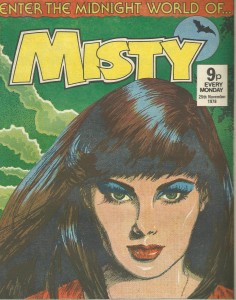
Jenni: Absolutely; you look on the shelves, there’s very little for a female audience. Bunty, for example, closed down a few years ago. Tammy, that you were mentioning, actually swallowed up a whole lot of comics – Jinty, and Misty both merged with it…This ‘merging’ of titles, where a few features from one title would be incorporated into a more successful one, was that something that was more specific to the girls’ titles than to the boys’?
Pat: No, that was general in the comics industry; it’s a disgusting policy. It’s called, “Hatch, Match and Despatch”; they talked about it with great pride. It’s a way of conning the newsagent – and nowadays, of course, W. H. Smith’s is too cunning for that sort of thing, you can’t do it any more.
A title comes out that sells say 250,000 per week. Every week, the distributor cuts the circulation by so much. At a certain point, the sales will be quite low, unless the readership is very, very loyal, in which case it will stick. So you get over this by merging two comics together, in which case their combined circulations will be taken into account. It’s horrible, it’s accountancy thinking. They were considering me at one point as being the kind of managing editor of all these different comics, and they asked me my views on “Hatch, Match and Despatch”, and I said I thought it was a disgrace.
It’s an appalling idea, it insults the readers. I think everybody here has had some experience of a comic they like being suddenly merged into this completely different title which they probably hate, this horrible shotgun wedding between the two…I think it treats the readers with utter contempt, and that it’s disgraceful.
Jenni: I’d like to talk also about some of the techniques and tactics that were used to boost or maintain circulation on a title, such as free gifts; there was a charm bracelet on the first issue of Misty, and Jinty had a little spider charm, the second had a free hairbrush… my sister literally bought Jinty because of the free item taped to the cover, and she didn’t buy any of the other ones on sale that week, so that obviously worked…
Pat: Oh, I wouldn’t criticise the policy of the free gifts, except to say that sometimes they were incredibly dull, and I had several run-ins with the guy who did the free gifts – for example, when I did Battle, I wanted to have Afrika Korps stickers, and the guy, who was a World War II veteran, said he would resign if I got my way! I said, “Well, look, bikers would buy it, because it’s not a swastika, it’s just a kind of German cross.” And he said, memorably, “We don’t want to attract those kind of readers.” That gives you some idea – you’re talking about people who by any criteria were from some kind of museum.
Jenni: So, not really looking to enlarge the circulation; if they wanted the title to be a success, you’d think they wouldn’t mind what sort of readers they got…
Pat: I think they had these ideas in their heads, perhaps from a time when comics had so many loyal readers, that it was almost like a license to print money, but by the ’70s, things were starting to get tougher, circulations were dropping, so they needed some modern thinking. And even that period was eventually, of course, going to be challenged by video and computer games.
Jenni: Going back a little further, prior to the 1970s, you obviously had this great number of titles in both the boys’ and girls’ markets; Girl, for instance, Diana is an early one… when we talked before, you were referring to how you were trying to react to that context of a fairly conservative set of stories, an entrenched view of what the comic for kids should be; could you outline for us what that kind of context was, and how you reacted to it?
Pat: Well, let’s take girls’ comics; before Tammy, you had a number of comics like Diana, or Princess Tina, which were aimed at middle-class girls. The ‘nice’ comics; there was Girl, which was a companion to Eagle. Then along came Tammy, which was nothing to do with me initially, it preceded me by perhaps as much as a year, and Tammy was a working-class girls’ comic. It had a very heavy ‘chip on its shoulder’ kind of message. It was edited by a guy called Gerry Finley-Day, who went on to work on 2000 AD –
Jenni: He wrote Rogue Trooper…
Pat: That’s right; he was an exceptional talent, who hasn’t really been given the recognition he deserves in the history of British Comics. I was very impressed with what Gerry was doing with Tammy, it was like Bunty, but stronger… it perhaps lacked some of the wit, the comedy of Bunty.
So, really, we took the thinking that applied to Tammy, and applied it to just about everything down the line that followed, whether it was Battle, Action, 2000 AD… For example, in the traditional war comics in the past, it had always been the officer class as heroes; there were no officer heroes in Battle. You were lucky to be a sergeant! And this seemed very normal to us, but the later titles were all fuelled by a kind of class-war concept.
Jenni: In fact, that’s a very good moment for us to look at Concrete Surfer from Jinty. This is the story of a poor girl, who’s come back from Australia, where her parents have emigrated to find a better life, she’s back and is living with her posh cousin, so there are the class-struggle themes you mention, but there are also these great action sequences, it’s also about Bertelman turns, a surf- and skateboarding move, and how girls can be as good as boys. So here’s an example of how you’re bringing in that class-consciousness, but in a story that has many other aspects to it.
Pat: Oh yes, it was very deliberate. It wasn’t a formula that I started by any means, and when I say ‘formula’ I don’t mean to imply that the story lacks any passion because it follows guidelines. But this was a style that had been designed in Tammy, and it had worked very well; you had the, to put it bluntly, smug middle-class bitch, and then the girl who’s less pretty and feeling bitter and twisted.
It worked phenomenally well. Concrete Surfer was only one in a long line. Probably my particular favourite was Ella On Easy Street, which was a wildly controversial idea, I don’t think you could get away with it these days, where she’s a working-class girl, she’s happy in her home, everything’s fine, but then her dad changes his job. And the whole family becomes affected by Yuppieism, and family life starts to go wrong, so she tries to sabotage it! She could pass exams, but she chooses not to, and, particularly the way I’m describing it here, it sounds appalling, but it was written so well, by Gerry and also by Charles Heron, that it worked. You were thinking as you read, “No, she’s right, why does Mum have to go off to night school?” and all that, it was a very seditious idea. I’m surprised that teachers and parents didn’t scream at the idea that maybe being happy was better than having lots of ‘O’ and ‘A’ levels.
Jenni: There is a well-known trope in children’s stories of ‘money can’t buy you love’, but what you’re saying goes further than that…
Pat: It went much further than that. It was beautifully drawn, by the way, by a Spanish artist called Casanovas who was really a classic artist.
Jenni: I would like to touch briefly on some of the names you’ve worked with, particularly artists, because in British comics, it’s often hard to tell who worked on it, as they were almost always uncredited. At least with an artist you can hope to recognize the style, see that “Well, the same person obviously did these three series”, but for a writer it’s much harder. In fact, it’s only talking with yourself that we’ve identified and publicly acknowledged some of the stories you’ve worked on – like Land of No Tears, with the Alpha Girls and the Gamma Girls in the far future, and the poor little crippled girl who is bolshy and annoying, and yet they learn – well, not to love her, but –
Pat: Yes, that story was about genetic perfection in the future, and therefore this very ordinary girl is faced with – it’s the old thing that pervades girls’ comics all the way through; elitism, and the struggle against it.
All in all, I think the message in Tammy was quite positive, and in Jinty too, but there were styles of stories that would seem pretty questionable these days – slave stories were always very popular, and I think a psychologist might have a field day, not just with the people who wrote them, but with the readers!
Jenni: Like the one from Jinty that’s one of my favourites, Slave of Form 3B, about the girl who finds out she can hypnotize her weaker-willed classmate, and makes her do all these things like helping her cheat at hockey, sabotaging her rival’s gym kit, and it descends disturbingly further until this poor weak classmate, Tania, is made to walk round this wall hypnotized, and she falls off in the middle of the night, and no-one finds her until the next morning…!
(Resounding laughter from audience.)
Jenni: … And the one who finds her is the evil girl – she’s obviously evil because she has dark hair in a bob – and she drags Tania into a shed by her ankles, throws a bit of burlap over her, and thinks, “Well at least now if they find her, I won’t be connected with her!”
(Laughter)
Jenni: This poor girl nearly died, and at the end she’s in a wheelchair, not permanently, but she’s rewarded by being acclaimed as the heroine of the school, and “Gosh, she’s so brave, she may even be head girl next year!”
Pat: Some of these stories were extraordinary, of course, but they were touching something in the readers’ consciousness, that’s why they were being done, these stories would not work in male comics, it’s….shall we say, not a male fantasy. We tried, and they failed.
Jenni: It may be a female fantasy – mostly –
(Knowing laughter from audience.)
Jenni: – but given the kind of bullying that goes on between girls…
Pat: We actually would sit down and say, when we were constructing a girls’ comic or revising an existing one, “Right, let’s have the slave story”, and the reason was because they were so popular with the readers! The one you just described is actually quite mild compared to others I’m aware of… I wrote one called Captives of Madam Karma, the details of which I’m too embarrassed to repeat even now, it was pretty cruel!
There was another one – which wasn’t mine, so I’m quite happy to talk about it – called Slaves of War Orphan Farm, which I think tells you everything. It worked like this; if you – if we were constructing a girls’ comic now, obviously times have changed, but I can’t imagine the collective psyche is that different – we would have a Slave story, what we called a Cinderella story, where the heroine’s down on her luck, we’d have a Friendship story – these were the three lynchpins. The friends’ story was very important.
Just an important digression, because she’s such a good writer that I have to mention her, Pat Davison was the most important girls’ comic writer, she was very talented, the rest of us, if you like, were following in her shadow, seeing how she did it and probably copying her, but she really was the star, and yet nobody knows her name, so I’m taking this opportunity to mention her.
Jenni: Can you tell us any specific series that she wrote?
Pat: Oh yes. She wrote Little Miss Nothing – beautifully drawn by a Spanish artist. Inevitably, cruel relatives and all the rest of it – but it was that lightness of touch… Generally, it was male writers in this field. I think Pat Davison is the only woman I can think of who genuinely had a better touch in the way she did this, she wrote far more from the heart, the rest of us were 23-year-old guys killing ourselves laughing as we wrote this stuff, but she wrote from the heart, and it was quite genuine. Little Miss Nothing was in Sandie, and it was so popular, that we did that thing that everyone does in publishing even to this day, which is to look at it, and dissect it, and try to duplicate it. We were told; “Right, do something like Little Miss Nothing”, and we ended up with all these limitless variations… just like the superheroes, you start off with Superman and Batman, and before you know it, you’ve got millions of different superheroes. Same thing; same formula.
Jenni: So did you think that the formula actually helped you in your work, that you came up with things you mightn’t otherwise have come up with? How restricting, or liberating, was it?
Pat: The formula on girls’ comics was actually quite good, you had a lot of freedom but you still had some guidelines. On male comics, boys’ comics, the formula was much more questionable.
Jenni: More questionable in the sense of less effective?
Pat: Yes, I think so. I couldn’t even say why, but the formula was distasteful on the male comics.
Jenni: In previous discussion, you’ve mentioned the different formulas that were used in girls’ comics – for example, the Slave story, the Cinderella story, and so on – and in the boys’ comics you don’t have so much of the context, you don’t have so much of the friends –
Pat: There are distinctive differences, many of which made me quite cross, because when we did Battle and so on, we followed the girls’ comic model, and my boys’ comics were, and I take great pleasure in saying this, disguised girls’ comics! Sometimes that formula didn’t work, but most of the time it did… I’ll give a couple of examples of when it didn’t work, which really shows the difference between the sexes.
Mystery stories – female readers love mystery stories, say a school where there’s a mysterious headmistress, and girls are disappearing, and other girls are turning up in the dormitory – this gets them going! And the explanation can be complete crap, and it usually was, and it doesn’t matter!
We tried this with male readers, we only did it once, and they hated it! That was Terror Behind the Bamboo Curtain… You could see the thinking; we had the sadistic Japanese commander of the prisoner-of-war camp, and prisoners are disappearing, and strange things are going on, and the readers DID NOT CARE!
 They weren’t bothered about the mystery, they just wanted to see the action! What was the Terror Behind the Bamboo Curtain? Who cares, bring on the violence! A female readership, even if you’ve got a mystery as simple as “What’s inside that box?”, that’ll keep them going for weeks! It’s a fundamental difference between the sexes.
They weren’t bothered about the mystery, they just wanted to see the action! What was the Terror Behind the Bamboo Curtain? Who cares, bring on the violence! A female readership, even if you’ve got a mystery as simple as “What’s inside that box?”, that’ll keep them going for weeks! It’s a fundamental difference between the sexes.
Another example, that really pissed me off; on Action, we did this story loosely based on The Fugitive, called The Running Man, about a guy on the run from the Mafia, and of course The Fugitive was a success for an adult audience, but the young male audience? “He’s running away! He should just kill ’em all!” The audience’s sympathy was with Crazy Luigi with the axe! (Audience laughter) Whereas in a girls’ comic, a Fugitive story, where the heroine’s running away from something, that’s fine… I’m sure there’ve been several.
Jenni: Oh, yes, there’s a whole swathe of them in Jinty alone. I remember Song of the Fir Tree, two orphans just after the Second World War, who don’t know that their father’s still alive. They escape from a concentration camp, and there’s this Nazi officer from their local village, who put them in the camp, and he wants to kill them, so they won’t be able to dob him as a Nazi! And following behind him is the kids’ father. They’re getting home to Norway, and none of them quite meet each other until the next to last page!
Pat: Sounds like a great story. Obviously written with conviction.
Jenni: I also want to talk about – you’ve mentioned Pat Davison, but other people you’ve worked with in the same context – John Armstrong was one that you’ve mentioned in other conversations, for example. He illustrated Moonchild. The reason I got to know Pat in the first place was that at a convention in Norway last year, John Armstrong, Pat and various other comics creators had been invited to go, because in Norway there’s been a lot of reprinting of British comics. It was ironic that I had to go to Norway to meet these people from the British comics industry!
John Armstrong is a very recognisable artist; girls who read comics of this era would recognise and remember him. He identified each page he drew with a little hidden monograph, but his style’s very recognisable because it’s this very realistic, photo-referenced work. John’s a great favourite of yours, I believe.
Pat: Oh, yes. I think John Armstrong is incredible. To me, he’s like Joe Colquhoun, he’s of that standard. Moonchild was the lead in Misty when it started, and I believe that if all the stories had been of that quality – and some of them were – Misty would still be around. His work is very immediate, and it has a sophistication about it that’s difficult to achieve. Concrete Surfer, for instance, is very nicely done, but it doesn’t have that quality, which Moonchild does. John is a really great artist.
Jenni: In subsequent issues, you see the development of the heroine’s mysterious power, how did it come about, what can she do with it, what can it do to her, essentially…It’s all very Carrie, isn’t it?
Pat: Moonchild was quite deliberately based on Carrie. When I talked about starting Misty, I said we should look at all the kinds of female adults’ fiction that were around at the time, and do girls’ comics versions of that. It was a deliberately calculated policy to do Carrie, to do Audrey Rose, which I did as Hush, Hush, Sweet Rachel, we never quite got around to doing Flowers in the Attic, but it was definitely on the list – but most of those female mystery books that were around, we did good girls’ comic versions.
When Misty moved away from that, and got caught up in silly traditional stuff, that’s when it lost its way. It was a great pity. What would happen – there was a policy at that time which I think is worth mentioning, because it might just explain what we were up against back then, and explain some of the strange anomalies that appeared in the comics. They had this idea that if you were an editor, you could work on anything, so one week a guy who had worked in the nursery department, where he was the editor of such titles as Fun To Know, Bobo Bunny, whatever, and then there’s a vacancy on Action, so they stuck him on one of the most violent and aggressive comics ever!
Similarly, what happened to me was the editor of Sally, which was an ancient comic, was offered to me on Action. I said no, because he was of a different generation, he wasn’t suitable, and he ended up as editor of Misty, which was entirely wrong. It needed to be somebody who was into this kind of Stephen King material. It’s not really an age thing, but you had to be into the source material. You knew, the minute they put the wrong editor on a magazine, that it was doomed, and your heart really sank, because you were offered very strange people. You just didn’t know what to do. What I tended to do was start a comic, and when it was up and running I’d just walk away from it, otherwise you’d just make everyone’s lives miserable.
Jenni: And yet 2000 AD has survived…
Pat: Because we had reasonably good starting-up people. The key thing is the first twelve to fifteen weeks, if you’ve hooked your readers and gotten out of the free gift period, to a regular readership that’s got the habit. That was when I knew 2000 AD was secure, and I could move on.
Jenni: But how did it happen then that some things – Jinty is the best example I know – that goes on six, seven, eight years, but it’s still eventually amalgamated into another title?
Pat: I can’t be 100% sure of this, but I’m pretty certain… I started Jinty with Malcolm Shaw, another very important girls’ comic writer, who sadly passed on quite a few years ago, but he contributed to 2000 AD, Tammy, very good writer indeed. Then it was taken over by Mavis Miller, who, as I mentioned earlier, had previously edited June and School Friend, and she adapted to the changes. Jinty was Mavis. So I’m sure that the stories that you and the other readers liked and remember, it’s her, it’s written over every issue. After she left to get married, Jinty began to falter.
There was always this rivalry between the Jinty editors and the Tammy editors, but Mavis had got it right, she knew her readership, she knew what she was doing, and whoever took over, I don’t remember who it was, that was when it went under. I think if Mavis had stayed the course, Jinty might be around today.
Jenni: It does become a question, though, not just of those initial twelve weeks, although they’re formative, but also of the personality and continuity of the people working on it…
Pat: Yes of course. The first twelve weeks are critical, but then it does depend on who follows it.
Again, to give you an anecdotal example, Pat Davison, she was working on Dutch Tina with her husband, Alan, and she said, “Look, we’d like a credit on our work, we’re getting a credit in Holland, we’d like a byline.” And the managing editor said, “No, if you have one, then everyone will want one,” and she said, “Okay. So what?” This was seen as real revolutionary behaviour, to want the credit for your own work!
Jenni: That did come in eventually, a few years later.
Pat: In girls’ comics?
Jenni: In Tammy, a few years later, before it finished.
Pat: It was deemed that it would start a dangerous precedent, and that’s an attitude that I have to say, has not disappeared from British or American comics to this day. I have seen editors face down artists or writers just to prove they can. It’s not even mostly about profit with some people, it’s about power.
I don’t understand it; Pat Davison was writing beautiful stories that girls were crazy about, rushing out and buying – she wants her name on the comic? Give it to her! She wants more money? Within reason, give it to her! To me it’s simple, it’s supply and demand. But no, the attitude of too many editors is “You want more? Fuck off!” So she left, and we lost someone who I thought was, within her field, the equivalent of Alan Moore. She should be as revered, as known, as Alan. And to me, that’s a tragedy.
Jenni: I think at this point we could throw it open to questions.
Chris Smilie : (A question about the revival of some IPC characters)
Jenni: I think the rights are complicated, aren’t they?
Pat: You’ve got the IPC era, and then the Egmont era. Egmont owned Battle, Action and 2000 AD… It’s possible they own the girls’ comics stuff as well, I’m not sure, but I really don’t think so.
A long while ago, John Wagner and I put a proposal to adapt the British girls’ comics and try to do them for America. Change the spelling, maybe upgrade one or two stories, but we figured that they could be adapted to the US market. Needless to say, we couldn’t get anyone interested, but some of the classic stories, such as Little Miss Nothing, by Pat Davison, would have adapted, and if we could have presented it in a format that would have been acceptable to the Americans, I think that would have been a classic.
Chris: (Inaudible except for “would you be interested in making it happen?”)
Pat: I certainly would, because I think it’s a shame that all this talent has been unrecognised. But I don’t see it happening. Comics are so steeped in male thinking, it is a male club, and they will pay some lip-service to female readers, female writers and artists and so on, but generally it’s quite negative. That’s based on my own experience, from female artists I know. They’ve told me, “Do I want to work in this world? It’s too bloody male!” And that’s a shame.
Jenni: On the question of rights (addressing CS) is it yourself who reprinted Leopard of Lime Street?
Chris: Yes.
Jenni: So you actually did request rights from Egmont? So, certainly there is an example of the rights being obtained for a reprint.
Chris: I did actually request them from IPC as well, but they wanted £150 pounds per page.
Pat: What?
Jenni: So how did you actually know what to request from Egmont or from IPC?
Chris: I put up a poll on my website asking what people wanted to see reprinted. First was the Steel Claw, but that had already been done in the 1980s by Quality Comics. Second was The Leopard of Lime Street, Adam Eterno was third, so I asked about those two, and got very different prices!
Pat: Where was Leopard of Lime Street?
Chris: It was from Buster, it ran from 1976 to about 1984, and was one of Britain’s longest-running super-heroes.
Jenni: What I really meant by my question, though, was how did you know which stories to request from which company?
Chris: I didn’t; it was Gil Page, he’s actually the licenses officer for both IPC and Egmont, and he knows which characters are which, and he knows that IPC doesn’t know…
(Audience laughter)
Jenni: So, you could have asked him to pretend, then…!
Q: (Largely inaudible, the gist is, “how did you tell which girls’ stories were popular, and what you were doing to make them popular” with reference to the earlier-discussed popularity of ‘slave’ stories.)
Pat: The same way we did with the boys’ stories. It was a bit like working in a straitjacket, you had these popularity polls, little boxes on the readers’ page, and the readers would write-in which three strips they liked most – and sometimes, too, the one they liked least. So you pretty soon knew.
They were accurate, but they could result in some quite dictatorial stuff from the editors. The same thing applied in 2000 AD, if you had an episode that was perhaps a little slower, a little more cerebral, the story would go down in the votes, and the editor would literally ring you up and say, “It’s dropped five points this week!” They had graphs, with different coloured lines – they took it all that seriously! – and you’d see the point where the story was at its most popular, usually where something truly horrible was happening to somebody, and they’d want it like that all the time, whether it was boys’ or girls’ comics. So the natural flow of drama, which applies in any other medium, where you have high points, slow points, that didn’t apply on these comics, they had to be white-heat the whole time.
I should also say that the same applied to the comedy comics. I wrote, God help me, ‘fun’ comics, though I question the validity of the word – Whizzer & Chips, I wrote a stream of those, I think it made me almost suicidal, they are just not funny. I used to write some of the lead stories in there. I really needed the money that badly!
Q: (Something about matching writers with artists for particular types of strips.)
Pat: Ah well, John Armstrong, he was an all-rounder, he could do anything. Sports stories, horror, you could put him on any strip. But if you’re talking about an animal story, for example, if you had a Disney-like story about the adventures of a cute cat or a cute dog, something like that, it had to be Casanovas, nobody could draw animals like Casanovas.
Jenni: He did Dora Dogsbody in Jinty, who looked after a bunch of dogs in a kind of dog hotel…
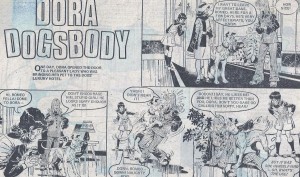 Pat: I think I may actually have written one or two of those, some of these things I wasn’t very good at, and Dora Dogsbody I was hopeless at, but yeah, with that one you would go for Casanovas, he was in high demand for animal stories.
Pat: I think I may actually have written one or two of those, some of these things I wasn’t very good at, and Dora Dogsbody I was hopeless at, but yeah, with that one you would go for Casanovas, he was in high demand for animal stories.
One he did for Bunty called Inky, it was really very beautiful. Aimed at younger girls, but lovely work. So if you had something like that, you’d look for a suitable writer. For the more formulaic stories, you could pretty much pick any of us, but probably for Inky, or the equivalent in Sandie, which was a cat story, you’d go to someone like Pat Davison if you could get her, you’d look for a sensitive writer. We were aware of these differences, and you’d pick people who were more appropriate to the subject matter.
Q: (Something about cruelty, and whether it’s particularly appropriate for a British market!)
Pat: I think there’s a long tradition from Dickens onwards of this kind of story. If you look at EastEnders, or Grange Hill –
Q: (Inaudible interjection.)
Pat: Oh, specifically to girls, you mean? There would tend to be psychological cruelty, they seemed very into the Victorian things, like No Tears For Molly, which was based on the TV show, Upstairs, Downstairs, about the downtrodden below-stairs maid. Judy had one of those that ran for years and years, called, and I think the title says it all, Wee Slavey. I’m not sure how all this originated, but it certainly did have something to do with that Victorian tradition. And it still continues today. Grange Hill had very much that feeling.
Q: ((Male questioner)) – Were there any girl’s comics that didn’t end with ‘y’ or a ‘y’ sound in the title?
(Laughter)
Jenni: Perhaps for very little girls… Diana!
Pat: There was Pink, although that was a little bit more mature, I think… Yeah, mostly they were all ‘y’ or ‘ie’; Sandie, Tammy, Jackie…
Jenni: Jinty, Misty, Bunty, Mandy, Judy, Sally…
Pat: The thing was, if you were on a roll with these things then you did tend to stick to a winning formula. That applied to boys’ comics too; there was a phase before I came along where you had Tiger, Jag, Lion, I’m surprised they didn’t do Rhino, they went through the zoo.
Q: (Another female questioner asking about boys reading girls’ comics.)
Pat: Yes, I did it myself, you’d read all this romantic stuff as a kid, and you’d laugh at it, but I think you’d be aware that there was this crossover.
Q: (Same questioner, something like, “I read Spider-Man and 2000 AD, but then I realised that none of the other girls were reading that kind of thing…”)
Jenni: If you’ve got a brother and a sister in the same house, they’ll read each other’s comics, though. I read my brother’s Whizzer & Chips, and he read my Jintys, and he remembers Jinty far better than I remember Whizzer & Chips now!
Pat: Which I can understand, given the low standard of Whizzer & Chips, a lot of which I was responsible for! Thoroughly unmemorable!
Jenni: Unfortunately, I think we have to wrap it up now; Thanks to everyone for coming, and particularly to Pat for sharing his insights into the British comics industry, and giving some long-overdue credit to names that have been unknown for too long!
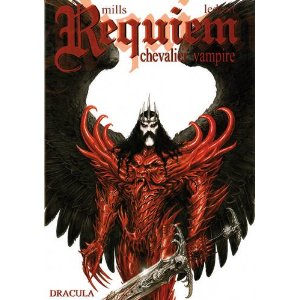 Following this interview, Mills continued to be one of the more prolific writers in comics, working steadily for 2000 AD and a multitude of other publications. He also has written screenplays and audio plays, and his primary recent comics project is Requiem, Vampire Knight, in conjunction with artist Olivier Ledroit, the fifth volume of which is to be issued in November 2011
Following this interview, Mills continued to be one of the more prolific writers in comics, working steadily for 2000 AD and a multitude of other publications. He also has written screenplays and audio plays, and his primary recent comics project is Requiem, Vampire Knight, in conjunction with artist Olivier Ledroit, the fifth volume of which is to be issued in November 2011
Transcription and framing text by Will Morgan.
Tags: 2000AD, British Comics, girls comics, Jinty, Misty, Tammy

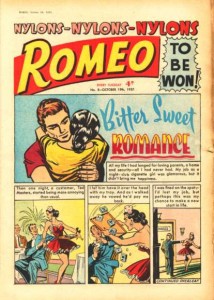
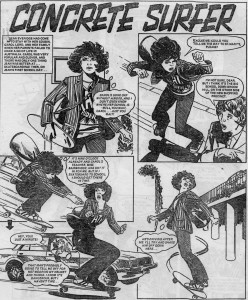
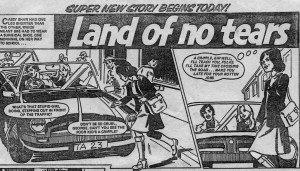
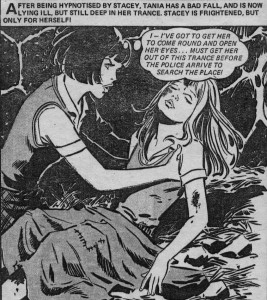
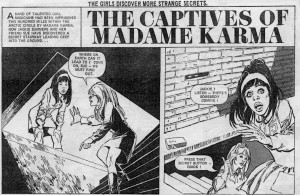
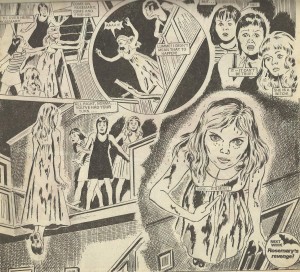
After reading this I wanted to read ‘The Terror Behind the Bamboo Curtain’, and I found the reprint in the 1980 Tornado annual. I haven’t read any boys’ comic stories to compare with this one. However, I can compare Bamboo Curtain with the slave stories in the girls’ comics.
Yes, I can definitely see the girls’ slave story formula at work in it. But catch the girls taking punches at their oppressors before it’s time for the full-bloodied final showdown! Even in this disguised girls’ comic story there was still a difference between the sexes.
One of the Tammy annuals did talk a bit about popularity polls. It was interesting to read that it wasn’t unusual for a serial to start out unpopular but become more popular as it progressed and developed. So was the weekly story coupon that dictatorial? Could it really cut a serial short? I suppose it depends on the editor.
I imagine some serials couldn’t be cut short that easily because of their structure; they had to run their course. But I have read some serials that I felt were cut short and ended too quickly. One was ‘Come Back Bindi’, the last Tammy story written by Jenny McDade. Others were Jinty’s ‘Worlds Apart’ and possibly ‘Dracula’s Daughter’, but this was because of the upcoming merger with Tammy.
Actually, Egmont does own the right to the IPC girls’ titles.
[…] And the readers lapped it up. Its length alone – a staggering 29 episodes – shows how popular it was with readers. Its formula proved a guaranteed hit, copied countless times at IPC, and spawned what became known as the slave story. Or perhaps, more accurately, the slave group story (as distinct from the single slave story). The slave story was one of the lynchpins in the new trend of grittiness Tammy set. Said Pat Mills of the slave story: “slave stories were always very popular, and I think a psychologist might have a field day, not just with the people who wrote them, but with the readers! … We actually would sit down and say, when we were constructing a girls’ comic or revising an existing one, ‘Right, let’s have the slave story’, and the reason was because they were so popular with the readers!” (Interview with Jenni Scott, 26 September 2011, https://comiczine-fa.com/interviews/pat-mills). […]